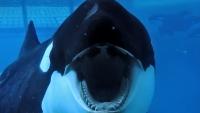
Tilikum Photo: Suzanne Allee/Magnolia Pictures
In February of 2010, the orca, Tilikum, attacked and drowned senior trainer, Dawn Brancheau, at SeaWorld Orlando. This was the third human death that Tilikum has been involved in, in captivity. Ironically, even though orcas are best know as “killer whales,” there has never been a recorded killing of a human by an orca in the wild. Sadly, the same cannot be said of orcas in captivity.
Blackfish, a new documentary, which opens today, “tells the story of Tilikum, a performing killer whale that killed several people while in captivity. Along the way, director-producer Gabriela Cowperthwaite compiles shocking footage and emotional interviews to explore the creature’s extraordinary nature, the species’ cruel treatment in captivity, the lives and losses of the trainers and the pressures brought to bear by the multi-billion dollar sea-park industry.”
Even before its release, Blackfish has been the center of controversy, as Sea World has reacted stronly to the movie. As reported by the New York Times: “SeaWorld Entertainment startled the film world last weekend by sending a detailed critique of the movie to about 50 critics who were presumably about to review it. It was among the first steps in an aggressive public pushback against the film, which makes the case, sometimes with disturbing film, that orca whales in captivity suffer physical and mental distress because of confinement. Magnolia and the film’s director, Gabriela Cowperthwaite, shot back with a point-by-point rebuttal in defense of the movie.”
The movie was recently reviewed by the New York Times:
Do Six-Ton Captives Dream of Freedom? ‘Blackfish,’ a Documentary, Looks Critically at SeaWorld
Unapologetically designed both to inform and affect, Gabriela Cowperthwaite’s delicately lacerating documentary, “Blackfish,” uses the tragic tale of a single whale and his human victims as the backbone of a hypercritical investigation into the marine-park giant SeaWorld Entertainment.
Denied on-camera interviews with park executives, who have strenuously taken issue with the film’s contentions in a lengthy news release, Ms. Cowperthwaite tells the distressing story of Tilikum, a 12,000-pound bull orca implicated in the deaths of three people. Through the rueful voices of former trainers and whale experts, a narrative driven by disillusion and regret unfolds as the trainers point to a gap between SeaWorld’s public image and behind-the-scenes reality.
Seemingly supported by chilling video and the oral testimonies of two witnesses to Tilikum’s first attack in 1991, the trainers accuse SeaWorld of cover-ups and misinformation. Much of the footage is painful to watch: bleeding whales, flanks raked by the teeth of their fellow captives; a trainer crushed between two gigantic beasts with only his wet suit holding him together; another trainer dragged repeatedly to the bottom of a pool until he manages to escape. Providing context for this alarming behavior, researchers describe highly socialized, caring creatures used to living in thousands of miles of ocean and ill suited to theme parks where they may be subjected to repeated overnight confinements in dark concrete pens.
Blackfish & Blackstone
Blackfish appears to have annoyed Blackstone, which has a considerable stake in protecting Sea World’s reputation.
SeaWorld Entertainment is owned by the Blackstone Group. Blackstone acquired Sea World from Anheuser-Busch InBev in 2009. In an initial public offering last April, Blackstone raised $700 million in new funds while still retaining control over the business.
As noted by Al Lewis the Wall Street Journal: Orlando-based SeaWorld runs 11 theme parks, including Busch Gardens in Tampa and SeaWorlds in Orlando, San Diego, and San Antonio. None of the more than $700 million raised in its IPO will go to Shamu the whale, Puck the penguin or anything else that swims in the parks. The money is going to retire debt and pay some enormous fees.
Buyout firm Blackstone Group BX +1.11% flooded SeaWorld with debt when it purchased it from Anheuser-Busch for $2.3 billion in December 2009. Blackstone put down $1 billion in cash and financed the rest.
Friday’s opening IPO price of $27 a share valued SeaWorld at about $2.5 billion. The company has more than $1.8 billion in long-term debt. Or as it warned in its IPO registration statement, “We are highly leveraged.” Nevertheless, the IPO did very well, rising more than 25% to nearly $34 a share on its first day of trading.
Blackstone will use IPO proceeds to pay itself $47 million for terminating its 2009 advisory agreement with SeaWorld. In March 2012, Blackstone paid—mostly to itself— a $500 million dividend from SeaWorld’s coffers. This was on top of a $110 million dividend in September 2011. And—get this—after bagging millions more in Friday’s IPO, Blackstone will remain SeaWorld’s controlling shareholder.
It has recouped its cash and more than doubled its initial investment in three years.

If there was more benefit to the practice (e.g. captive breeding, critical scientific research) I could see making an argument in favor of keeping cetaceans in captivity, if done as humanely and safely as possible. However, as it is, the whole system is geared towards profit and entertainment with a thin veneer of education as justification.
Quite a heartbreaking documentary, but I am starting to wonder how much better this might have been if they made a stronger push for getting both sides of the story in it.